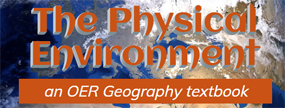 CONTENTS | ATLAS | GOOGLE EARTH
CONTENTS | ATLAS | GOOGLE EARTHChapter Review Assess your understanding of concepts related to this by answering the questions below. Click the question to reveal the correct answer.
Geography is the study of the distributions and interrelationships of earth phenomena. Geography is described as a spatial science.
Geographers integrate information about human and natural processes to
explain the pattern and relationships of earth phenomena. It is this
spatial approach that distinguishes geography from other disciplines.
The geographic continuum
represents the continuum of study within geography. Though geography can
be broadly separated into human and physical geography, geography is
actually a continuum as human activities and the natural environment
cannot be separated from one another. As one approaches the center of
the continuum, we see the intermingling of human and physical geography
as environmental science.
A large scale map, like 1:24000, covers a small area but show more detail than a small scale map. A small scale map, like 1:62500, shows a larger area, but little detail can be portrayed.
A model is a representation of something. For instance, a globe is a model of the Earth. Models may be mathematical statements that represent climate processes.
Graphs are used to show the relationships between earth phenomena. They can illustrate changes between earth processes and properties over distance and time.
Descriptive statistics like the mean, median, and mode characterize the nature of a set of data as a single number.
A geographic information system is a method where by "layers" of geographic data are overlaid to show the spatial correlation of earth processes and properties. Soil, topography, and vegetation data layers could be overlaid to assess erosion potential.
Air photos give us a real world view of the earth’s surface, unlike a map which is a representation of the real world. Aerial photographs can be used to make the same measurements that we make on a map, as they too are a scaled image of the surface. Satellite imagery due to the location of the sensor, can give us a larger view of the earth. A variety of satellite imagery display techniques exist, like simulated natural color, or "false" color, each being useful in their own way for studying earth surface processes and properties. High-resolution imagery is also useful in detailed, close-up viewing.
Latitude is measured in angular degrees north or south of the equator. Lines of latitude are called "parallels" as they parallel each other from the equator (0o latitude) to the pole (90olatitude. Lines of longitude are measured in angular degrees east or west of the prime meridian (0o latitude). Lines of longitude, or "meridians", are furthest apart at the equator and converge at the poles.
|